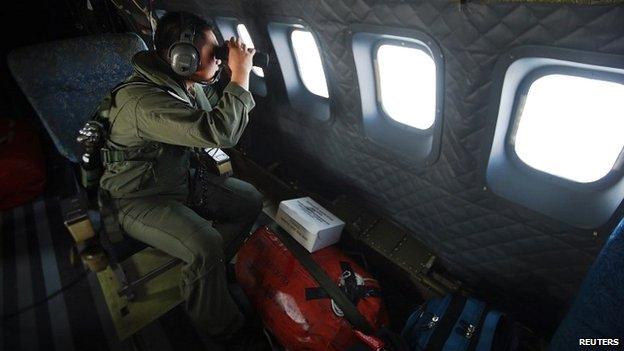Malaysia flight MH370: Theories swirl around disappearance
- Published

Dozens of aircraft are taking part in a region-wide search
The investigation into the disappearance of Malaysia Airlines flight MH370 has produced many false leads, and each one spawns a new theory.
Did the pilot make a mistake? Could an electrical fault have caused an explosion? Was it the target of a terror attack? Here are some of the main theories.

Pilot error

The Malaysia Airlines plane disappeared less than one hour after taking off
Aviation experts are shocked that an aircraft with a safety record as blemish-free as the Boeing 777-200ER could just vanish. So it is inevitable that attention turns to the previous incidents, and to the possibility of pilot culpability.
Pilots were blamed for the Air France flight 447 disaster in 2009. Investigators say the autopilot switched itself off after the speed sensors became blocked, and the pilots then steered the plane at too steep an angle before it stalled and crashed into the Atlantic, killing all 228 people on board.
But the weather on the day of MH370's flight was clear and sunny, so experts say it is unlikely that an experienced pilot could have caused a crash through unintentional error.
Another theory is a deliberate crash. The Aviation Safety Network says there have been eight plane crashes linked to pilot suicide since 1976.
Egypt Air flight 990, external in 1999 and Silk Air flight 185, external in 1997 are both thought to have been caused by a suicidal or vengeful pilot, though the claims can never be fully confirmed.
But with flight MH370 there is nothing to suggest that either the pilot, Capt Zaharie Ahmad Shah, or First Officer Fariq Abdul Hamid had any motive to end their lives or those of the passengers on board.

Mechanical failure

A single technical fault was blamed for bringing down TWA flight 800 in 1996
"All right, goodnight." The last communication between flight MH370 and Malaysian air traffic control provides no clues as to why the aircraft vanished just a few minutes later.
Initial reports suggested all signals had been lost simultaneously, bolstering the idea that the plane might have exploded or disintegrated at high altitude.
The closest investigators have come to a sign that a technical fault might have brought the plane down was a statement from a worker on an oil rig off the coast of Vietnam, who claimed to have seen a "burning" object.
TWA flight 800 exploded over the Atlantic in 1996, killing all 230 people on board. Investigators blamed that blast, external on an electrical short circuit near a fuel tank on the Boeing 747.
Doubts over the likelihood of this happening on MH370 have been raised by the lack of debris found in the huge search operation. But investigators might just be looking in the wrong place.
Some aviation experts have also raised the possibility that the aircraft might have suffered a power failure. If this had been the case the plane would have switched to a back-up generator. But it could explain why there have been mixed messages about the plane possibly changing course.
Another suggestion was that a sudden decompression of the cabin and cockpit had taken place, knocking the pilot and passengers unconscious. This could have meant the flight was able to continue on autopilot for some time - but again, the lack of debris casts doubt on this theory.

Terrorist attack

Interpol chief Ronald Kenneth Noble has said terrorism is an unlikely cause
The presence of two passengers travelling on stolen passports raised questions about a breach of security. But officials quickly identified both individuals as two young Iranian men hoping to emigrate to Europe and said they had no known links to terrorism.
Social media networks in China have been abuzz with fears that the 153 Chinese nationals on board the plane were the target of terrorists.
The disappearance came just a week after a knife attack blamed on separatists from Xinjiang province that left at least 29 people dead.
Malaysian officials have consistently said that they are not ruling out any theory.
But the head of Interpol, Ronald Kenneth Noble, has said: "The more information we get, the more we're inclined to conclude that it was not a terrorist incident."

A change of destination

Rumours that the engines sent data after the disappearance were quashed by Malaysian officials
Several reports have claimed that the plane was giving off signals for hours after it apparently disappeared, suggesting it could have flown as far as India or Australia.
The first report in the Wall Street Journal, external based its claims on data that Boeing said it had received from the aircraft's engines as part of a routine maintenance and monitoring programme.
It raised fears that the pilot or someone else on board could have intentionally switched off the transponder - which emits an identifying signal - and diverted the plane.
But Malaysia's transport minister said Malaysia Airlines and Rolls-Royce, the engine's manufacturer, both said the WSJ report was "inaccurate".
Later, unnamed US officials told several media outlets that the plane's equipment continued to ping data to satellites up to five hours after the apparent disappearance.
They said the data was inconclusive, but the US and India moved the focus of their search westwards into the Indian Ocean apparently in response to the claims.